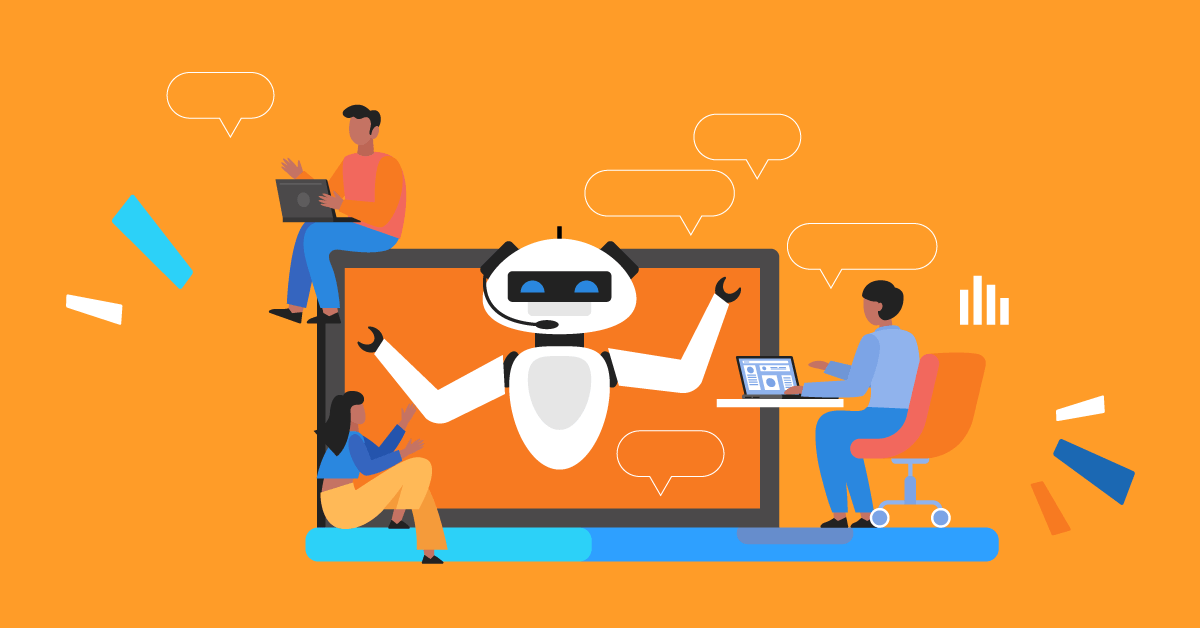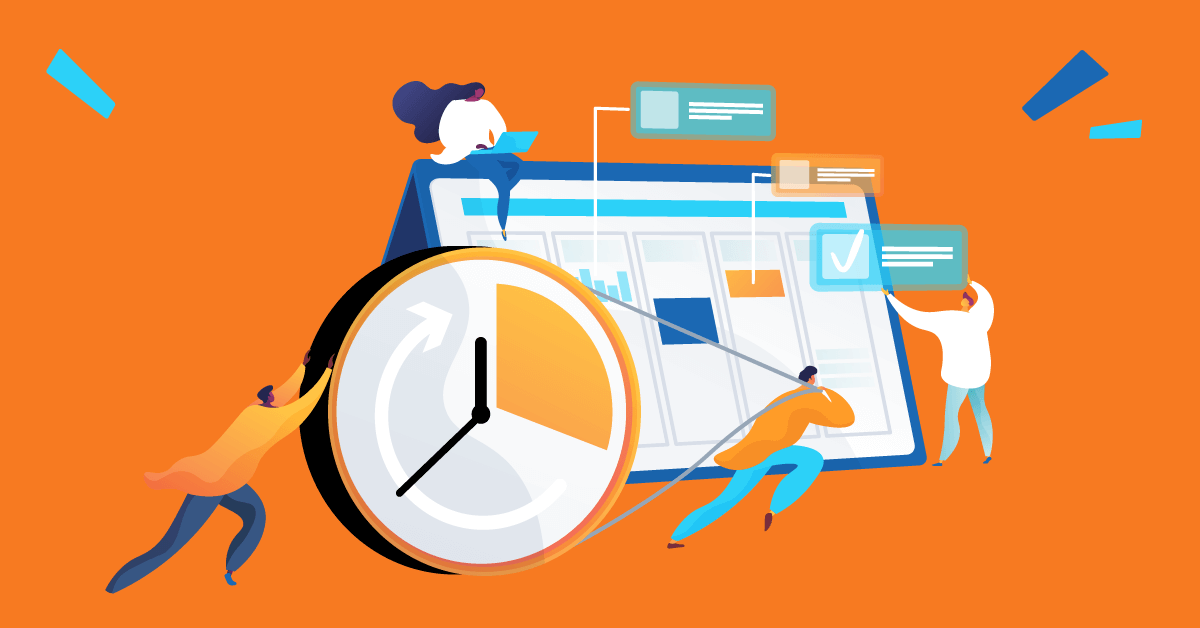Rumor has it that robots steal jobs from human workers.
Although the statement is kind of hyperbolic, the robot takeover is indeed in the spotlight because of the rise of AI tools like ChatGPT, DALL-E, and Jasper. And those tools are causing disruptions in the labor market.
You’ve already come across bots in the past few years—whether you realize it or not. Chatbots that act as customer service representatives. Apps that track packages. They’ve made our lives easier, and that’s why we use them daily. And they’ve built the base for AI technology.
Even if there’s a lot of drama around robots taking over our jobs, there’s no need to panic.
Robots aren’t replacing humans at such a rate, most people think. While 14% of humans claim to have seen their jobs being replaced by robots, in many workplaces, there’s a copresence of humans and bots. This human-robot collaboration has created a new form of a blended workforce, shaping AI and the future of work.
What it means to have bots in the workplace
When talking about human-robot collaboration, we’re not (necessarily) referring to actual human-like robots.
It’s all about leveraging advanced AI technologies, automation tools, and deep learning apps that can perform repetitive or complex tasks. These “virtual agents” lower costs and offer round-the-clock support in organizations.
As a result, humans have more time to do what they do best in more creative and decision-making tasks.
This digital shift will create an increasingly automated environment where humans and bots will work together as “digital colleagues.” A new blended workforce will bring impressive benefits to employees and organizations.
The impact on (human) employees
No, human employees won’t lose their jobs. However, they are going to be affected by the rise of AI tools in various ways.
In further detail, let’s explore how human-robot collaboration can transform the workplace experience for employees.
1. Processes become automated
With human-robot collaboration, workflows can be optimized.
AI tools assist businesses in streamlining any processes and systems as they offer insights into operations and areas for improvement. For example, managers can have AI-backed insights, daily reports, and suggested key actions they should take regarding employee performance, even weekly reports for coaching or acknowledgment. These time-consuming tasks can be minimized with the help of AI, so that managers can succeed in leading their teams the right way.
At the same time, AI tools can provide predictive models that explore potential issues before they arise. This way, companies can take precautionary measures to prevent any costly mistakes or serious delays. This helps businesses reduce costs and human errors.
2. There’s more room for personalization
When AI tools can analyze employee data and pinpoint skills gaps, it’s possible to provide customized learning experiences that cater to each employee’s needs. As a result, engagement, performance, and job satisfaction levels rise significantly.
AI tools are able to create personalized learning paths for each learner based on their:
- Prior knowledge
- Set of skills or skills gaps
- Topics of interest
- Development goals
- Current level and progress
These tools can conduct assessments based on the above-mentioned points and then recommend learning activities, resources, and objectives.
Boost learner engagement with TalentLMS
Build custom learning paths and deliver targeted courses.
The training platform that users consistently rank #1.
3. Decision-making becomes faster and better
Bots can assist with real-time decision-making by analyzing big data quickly and accurately.
Employees gather these valuable insights and recommendations and can make better choices faster than before.
For instance, AI tools offer managers real-time data on employee performance due to continuous assessment. Then, managers or supervisors can pinpoint and address any performance issues at the time they occur instead of waiting for the monthly, quarterly, or annual performance reviews. Providing feedback in a timely manner assists employees in performing better.
4. Collaboration is enhanced
Collaboration between employees becomes better with the help of AI-powered communication tools, as taking notes, transcribing meetings, and analyzing content become automated.
Also, AI-enhanced project management tools can assist with streamlining workflows and automating tasks, thus facilitating peer collaboration.
5. Work-life balance is optimized
Prioritization becomes better with the new blended workforce of humans and bots. AI tools assist employees in prioritizing tasks and processes based on importance or urgency while offering real-time feedback on the time spent on each task.
Time management also improves with the aid of bots. Employees can schedule their tasks more efficiently, as AI tools can suggest which is the best time for meetings or other activities.
Also, HR teams can benefit from AI-powered forms of feedback collection to make sure mental health in the workplace is taken into consideration. Employees are heard, and HR can act upon their feedback.

How human-robot collaboration affects businesses
The collaboration of humans and bots can bring tremendous benefits not only to employees but to the organization as a whole.
So, which are the benefits of fostering human-robot collaboration in modern industries?
1. Customer relations become stronger
Every organization focuses on engaging with customers. But these customer support processes have changed and will continue to change with the help of artificial intelligence tools.
Employees won’t have to put tons of effort into gauging a customer’s tone of voice so that they respond to customers’ concerns, complaints, or queries. Instead, AI tools, like live chatbots, will provide better, more dynamic, and faster responses to clients while cutting down the human hours needed to research solutions and minimize errors.
Human-robot collaboration in customer service builds stronger engagement and enhanced consumer trust. And happy customers will be more eager to stick with your company for longer, resulting in better business goals.
2. Recruitment is faster and more targeted
The hiring process is important to creating strong teams that support your organization. But for hard-to-fill roles, the hiring process can be long.
When you speed up the hiring process with AI tools, recruiters can focus on more creative things like building a talent pool, boosting the employer brand, etc.
Thus, by integrating AI tools into recruitment, organizations can find the perfect match for their job openings easier and quicker without sacrificing too much time, money, and resources.
Artificial intelligence tools can check if candidates are the best fit for an organization by using biometric or psychometric analysis to explore the candidates’ tone of voice, microexpressions and body language, online presence, skills, and more.
It’s important to highlight, however, that such tools can analyze behaviors and skills/potential based on the criteria you’ve previously set. Plus, provide insights on how well candidates match those criteria, and help recruiters shortlist candidates.
3. Cybersecurity improves
Data breaches are a serious issue for every organization. As cyber-attacks continue to grow and become more sophisticated, businesses must find solutions that protect them to the fullest.
A human-robot collaboration helps improve cybersecurity, and organizations have more chances of being fully protected against cyber attacks. Well-trained employees on cybersecurity, together with AI, can help businesses protect data, inspire trust, and add to the business value overall.
Meet TalentLibrary™
A growing collection of ready-made courses that cover the soft skills
your teams need for success at work
![]()

For instance, by powering AI tools for cybersecurity, it’s possible to eliminate the time needed for manually executed tasks. Scanning data, identifying potential threats, reducing false positives, and filtering out threatening or non-threatening activities can be automated with AI tools so that cybersecurity experts can focus on more critical security aspects.
Why businesses should adopt the new blended workforce
The core reason why businesses should opt for the new blended workforce of humans and bots is that one cannot replace the other.
AI can eliminate tedious tasks and increase focus to more crucial ones. People can become true specialists in their field or role as they have the time to spend on their development.
Having humans and bots working together must be taken into account, however. Organizations should invest in the artificial intelligence tools that best fit their needs but also design and provide the right training programs to enhance skills and competencies needed to thrive in a work environment that emphasizes human-robot collaboration.
In the podcast series “Keep It Simple” by TalentLMS, Ronald Ashri emphasizes the importance of basic AI training for everyone in his discussion on “Preparing for the AI-workforce.” The goal of this training is to demystify AI and shift people’s perception away from anthropomorphizing it.

The AI future of work
AI tools and bots are here to replace only some of the existing processes or the human factor. It’s here to improve things wherever applicable by helping organizations and employees work smarter.
The adoption of technology in the workplace is necessary for businesses to thrive. The human-robot collaboration is what will create a better work experience and bring amazing end-business results in the future.
Humans and bots will live–and work–happily ever after.


